A library for JPEG masking and composition in the DCT domain.
- Background
- Compiling and installing
- Compatibility
- Synopsis
- Example
- Who is using libmodjpeg
- License
- Acknowledgement
- References
With libmodjpeg you can overlay a (masked) image onto an existing JPEG as lossless as possible. Changes in the JPEG only take place where the overlayed image is applied. All modifications happen in the DCT domain, thus the JPEG is decoded and encoded losslessly.
Adding an overlay (e.g. logo, watermark, ...) to an existing JPEG image usually will result in loss of quality because the JPEG needs to get decoded and then re-encoded after the overlay has been applied. Read more about JPEG on Wikipedia.
The usual process of applying a (masked) overlay involved these steps:
- Huffman decode
- de-quantize
- inverse DCT *
- colorspace transformation from YCbCr to RGB *
- applying the (masked) overlay
- colorspace transformation from RGB to YCbCr *
- DCT *
- quantize *
- Huffman encode
The steps marked with a * will lead to loss of quality.
gm convert image.png -filter Lanczos -resize 256x256 -quality 85 image.jpg
gm composite dropon.png image.jpg -quality 86 image_composed.jpg
gm compare -highlight-style assign -highlight-color lime -file image_composed_diff.png image.jpg image_composed.jpg| Original | Overlay | Composed | Difference |
|---|---|---|---|
 |
 |
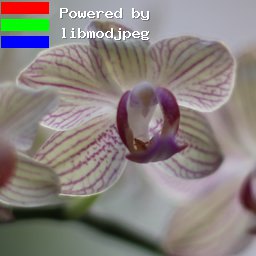 |
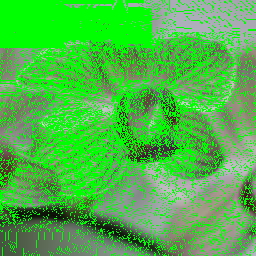 |
The composed image above has been saved with a quality setting of 86. Only if the quality settings of the original image are known, the composed image can be saved with the same quality settings in order to have almost no changes outside of the area of the overlay.
gm convert image.png -filter Lanczos -resize 256x256 -quality 85 image.jpg
gm composite dropon.png image.jpg -quality 85 image_composed_sameq.jpg
gm compare -highlight-style assign -highlight-color lime -file image_composed_sameq_diff.png image.jpg image_composed_sameq.jpg| Original | Overlay | Composed | Difference |
|---|---|---|---|
 |
 |
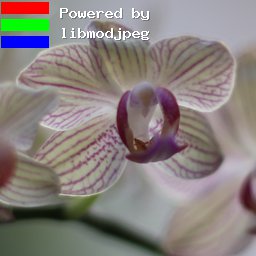 |
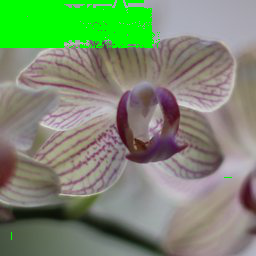 |
The composed image above has been saved with a quality setting of 85, which is the same quality setting as the original image.
libmodjpeg avoids the lossy decoding and re-encoding of the JPEG image by applying the overlay directly on the un-transformed DCT coefficients:
- Huffman decode
- de-quantize
- applying the (masked) overlay
- quantize
- Huffman encode
In step 4, the quantization is lossless compared to the usual process because the same DCT and quantization values are used as in step 2.
Only the area where the overlay is applied to is affected by changes and the rest of the image will remain untouched.
gm convert image.png -filter Lanczos -resize 256x256 -quality 85 image.jpg
modjpeg --in image.jpg --dropon dropon.png --out image_dropon.jpg
gm compare -highlight-style assign -highlight-color lime -file image_dropon_diff.png image.jpg image_dropon.jpg| Original | Overlay | Composed | Difference |
|---|---|---|---|
 |
 |
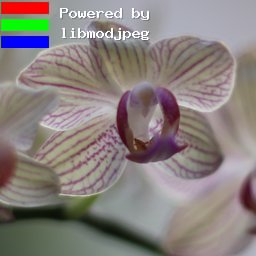 |
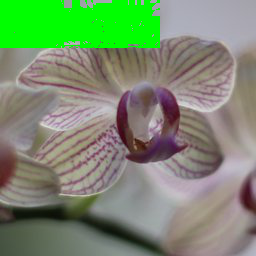 |
The overlay is applied with the modjpeg CLI program, that uses libmodjpeg in order to apply an overlay to a JPEG image. The quality settings of the original image can remain unknown. Changes to the image will only happen where the overlay is applied.
The overlay itself will experience a loss of quality because it needs to be transformed into the DCT domain with the same colorspace, sampling, and quantization as the image it will be applied to.
See all sample images for libmodjpeg.
libmodjpeg requires the libjpeg or compatible (libjpeg-turbo or mozjpeg), however the IJG libjpeg or libjpeg-turbo are recommended because mozjpeg will always produce progressive JPEGs which is slower and may not be desired.
It will be checked for libpng-1.6.x as well in order to support overlays in PNG format. PNG support is optional.
git clone https://github.com/ioppermann/libmodjpeg.git
cd libmodjpeg/src
cmake .
make
make installIn case libjpeg (or compatible) are installed in a non-standard location you can set the environment variable CMAKE_PREFIX_PATH
to the location where the libjpeg is installed, e.g.:
env CMAKE_PREFIX_PATH=/usr/local/opt/jpeg-turbo/ cmake .#include <libmodjpeg.h>
int main(int argc, char **argv) {
// Initialize dropon struct
struct mj_dropon_t d;
mj_init_dropon(&d);
// Read a dropon from a JPEG, without mask and with 50% translucency
mj_read_dropon_from_file(&d, "logo.jpg", NULL, 50);
// Initialize JPEG image struct
struct mj_jpeg_t m;
mj_init_jpeg(&m);
// Read a JPEG image from a file
mj_read_jpeg_from_file(&m, "in.jpg", 0);
// Place the dropon in the bottom right corner of the JPEG image
// with 10px distance to the bottom and right border
mj_compose(&m, &d, MJ_ALIGN_BOTTOM | MJ_ALIGN_RIGHT, -10, -10);
// Write the JPEG image to a file with optimzed Hufman tables and progressive mode
mj_write_jpeg_to_file(&m, "out.jpg", MJ_OPTION_OPTIMIZE | MJ_OPTION_PROGRESSIVE);
// Free the dropon and JPEG image structs
mj_free_jpeg(&m);
mj_free_dropon(&d);
return 0;
}In the contrib directory you find an example program that implements all described functionality.
cd src/contrib
cmake .
makeIn case the jpeglib (or compatible) is installed in a non-standard location, use the same environment variable for cmake as described above.
libmodjpeg has been tested with the following versions of libjpeg (and compatibles):
- libjpeg v6b (arithmetric coding will not work)
- libjpeg v7
- libjpeg v8d
- libjpeg v9c
- libjpeg-turbo v1.5.3
- mozjpeg v3.3.1
#include <libmodjpeg.h>Include the header file in order to have access to the library.
struct mj_dropon_t;A "dropon" denotes the overlay that will be applied to an image and is defined by the struct mj_dropon_t.
void mj_init_dropon(mj_dropon_t *d);Initialize the dropon in order to make it ready for use.
int mj_read_dropon_from_raw(
mj_dropon_t *d,
const unsigned char *rawdata,
unsigned int colorspace,
size_t width,
size_t height,
short blend);Read a dropon from raw data. The raw data is a pointer to an array of chars holding the raw image data in the given color space.
#define MJ_COLORSPACE_RGB 1 // [0] = R0, [1] = G0, [2] = B0, [3] = R1, ...
#define MJ_COLORSPACE_RGBA 2 // [0] = R0, [1] = G0, [2] = B0, [3] = A0, [4] = R1, ...
#define MJ_COLORSPACE_GRAYSCALE 3 // [0] = Y0, [1] = Y1, ...
#define MJ_COLORSPACE_GRAYSCALEA 4 // [0] = Y0, [1] = A0, [2] = Y1, ...
#define MJ_COLORSPACE_YCC 5 // [0] = Y0, [1] = Cb0, [2] = Cr0, [3] = Y1, ...
#define MJ_COLORSPACE_YCCA 6 // [0] = Y0, [1] = Cb0, [2] = Cr0, [3] = A0, [4] = Y1, ...width and height are the dimensions of the raw image. blend is a value in [0, 255] for the translucency for the dropon if no alpha
channel is given, where 0 is fully transparent (the dropon will not be applied) and 255 is fully opaque.
int mj_read_dropon_from_file(
mj_dropon_t *d,
const char *filename,
const char *maskfilename,
short blend);Read a dropon from a file (filename). The file can be a JPEG or a PNG.
If the file is a JPEG, then the alpha channel can be given by a second JPEG file (maskfilename).
Use NULL if no alpha channel is available or wanted. blend is a value for the translucency for the dropon if no alpha channel is given.
If the file is a PNG, then use NULL for maskfilename and any value for blend because they will be ignored. The alpha channel is taken
from the PNG, if available. PNG files are only supported if the library is compiled with PNG support.
int mj_read_dropon_from_memory(
mj_dropon_t *d,
const unsigned char *memory,
size_t len,
const unsigned char *maskmemory,
size_t masklen,
short blend);Read a dropon from a JPEG or PNG bytestream (memory of len bytes length).
If the bytestream is a JPEG, then the alpha channel is given by a second JPEG bytestream (maskmemory of masklen bytes length).
Use NULL for maskmemory or 0 for masklen if no alpha channel is available or wanted. blend is a value for the translucency for
the dropon if no alpha channel is given.
If the bytestream is a PNG, then use NULL for maskmemory or 0 for masklen and any value for blend. The alpha channel is taken
from the PNG, if available. PNG files are only supported if the library is compiled with PNG support.
void mj_free_dropon(mj_dropon_t *d);Free the memory consumed by the dropon. The dropon struct can be reused for another dropon.
struct mj_jpeg_t;The mj_jpeg_t holds the JPEG a dropon can be applied to.
void mj_init_jpeg(mj_jpeg_t *m);Initialize the image in order to make it ready for use.
int mj_read_jpeg_from_memory(
mj_jpeg_t *m,
const unsigned char *memory,
size_t len,
size_t max_pixel);Read a JPEG from a buffer. The buffer holds the JPEG bytestream of length len bytes. max_pixel is the maximum number of pixels allowed in the image
to prevent processing too big images. Set it to 0 to allow any sized images.
int mj_read_jpeg_from_file(
mj_jpeg_t *m,
const char *filename,
size_t max_pixel);Read a JPEG from a file denoted by filename. max_pixel is the maximum number of pixels allowed in the image
to prevent processing too big images. Set it to 0 to allow any sized images.
int mj_write_jpeg_to_memory(
mj_jpeg_t *m,
unsigned char **memory,
size_t *len,
int options);Write an image to a buffer as a JPEG bytestream. The required memory for the buffer will be allocated and must be free'd after use. len holds
the length of the buffer in bytes. options are encoding features that can be OR'ed:
MJ_OPTION_NONE- baseline encodingMJ_OPTION_OPTIMIZE- optimize Huffman tablesMJ_OPTION_PROGRESSIVE- progressive encodingMJ_OPTION_ARITHMETRIC- arithmetric encoding (overrules Huffman optimizations)
int mj_write_jpeg_to_file(
mj_jpeg_t *m,
char *filename,
int options);Write an image to a file (filename) as a JPEG bytestream. The options are the same as for mj_write_jpeg_to_memory().
void mj_free_jpeg(mj_jpeg_t *m);Free the memory consumed by the JPEG. The jpeg struct can be reused for another image.
int mj_compose(
mj_jpeg_t *m,
mj_dropon_t *d,
unsigned int align,
int offset_x,
int offset_y);Compose an image with a dropon. Use these OR'ed values for align:
MJ_ALIGN_LEFT- align the dropon to the left border of the imageMJ_ALIGN_RIGHT- align the dropon to the right border of the imageMJ_ALIGN_TOP- align the dropon to the top border of the imageMJ_ALIGN_BOTTOM- align the dropon to the bottom border of the imageMJ_ALIGN_CENTER- align the dropon to the center of the image
Use offset_x and offset_y to move the dropon relative to the alignment. If parts of the dropon will be outside of the area
of the image, it will be cropped accordingly, e.g. you can apply a dropon that is bigger than the image.
int mj_effect_grayscale(mj_jpeg_t *m);Convert the image to grayscale. This only works if the image was stored in YCbCr color space. It will keep all three components.
int mj_effect_pixelate(mj_jpeg_t *m);Keep only the DC coefficients from the components. This will remove the details from the image and keep only the "base" color of each block.
int mj_effect_tint(
mj_jpeg_t *m,
int cb_value,
int cr_value);Colorize the image. Use cb_value to colorize in blue (positive value) or yellow (negative value). Use cr_value to colorize in
red (positive value) or green (negative value). This only works if the image was stored in YCbCr color space.
int mj_effect_luminance(
mj_jpeg_t *m,
int value);Change the brightness of the image. Use a positive value to brighten or a negative value to darken then image. This only works if the image was stored in YCbCr color space.
All non-void functions return MJ_OK if everything went fine. If something went wrong the return value indicates the source
of error:
MJ_ERR_MEMORY- failed to allocate enough memoryMJ_ERR_NULL_DATA- some provided pointers are NULLMJ_ERR_DROPON_DIMENSIONS- the dimensions of the dropon image and alpha do not correspondMJ_ERR_UNSUPPORTED_COLORSPACE- the JPEG is in an unsupported color spaceMJ_ERR_DECODE_JPEG- error during decoding the JPEGMJ_ERR_ENCODE_JPEG- error during encoding the JPEGMJ_ERR_FILEIO- error while reading/writing from/to a fileMJ_ERR_IMAGE_SIZE- the dimensions of the provided image are too largeMJ_ERR_UNSUPPORTED_FILETYPE- the file type of the dropon is unsupported
libmodjpeg only supports the "basic" and most common color spaces in JPEG files: JCS_RGB, JCS_GRAYSCALE, and JCS_YCbCr
- modjpeg-nginx - NGINX filter module for adding overlays and logos to JPEGs on-the-fly without degrading the quality of the image.
libmodjpeg is released under the MIT license.
Made with 🍕 and 🍻 in Switzerland.
This software is based in part on the work of the Independent JPEG Group.
PNG support is provided by libpng
[1] R. Jonsson, "Efficient DCT Domain Implementation of Picture Masking and Composition and Compositing", ICIP (2) 1997, pp. 366-369